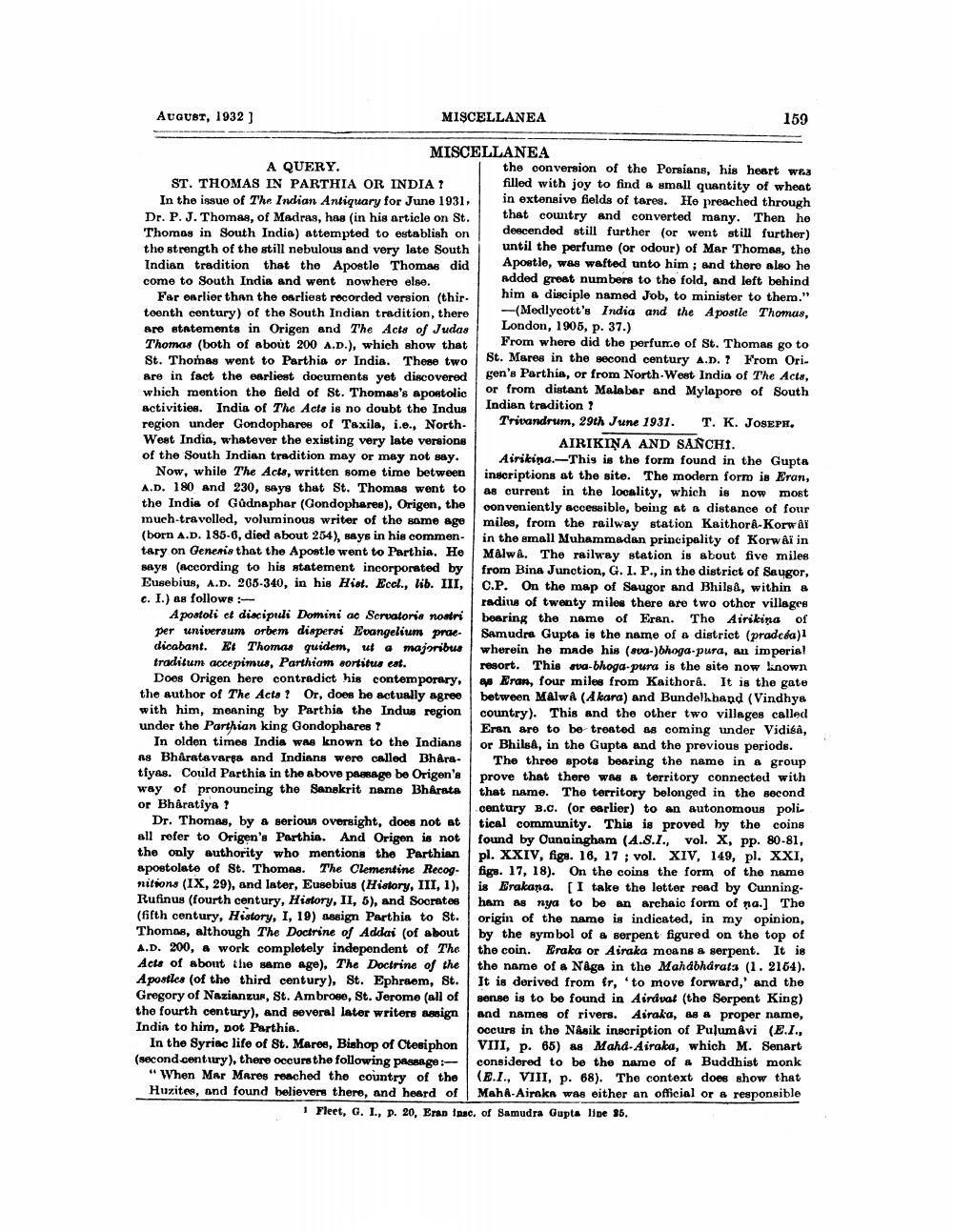________________
AUGUST, 1932)
MISCELLANEA
159
MISCELLANEA A QUERY
the conversion of the Porsians, his heart wh. ST. THOMAS IN PARTHIA OR INDIA ?
filled with joy to find a small quantity of wheat In the issue of The Indian Antiquary for June 1931,
in extensive fields of tares. Ho preached through Dr. P.J. Thomas, of Madras, has (in his article on St.
that country and converted many. Then he Thomas in South India) attempted to establish on
descended still further (or went still further) the strength of the still nebulous and very late South
until the perfume (or odour) of Mar Thomas, the Indian tradition that the Apostle Thomas did
Apostle, was wafted unto him; and there also he come to South India and went nowhere else.
added great numbers to the fold, and left behind Far onrlier than the earliest recorded version (thir.
him a disciple named Job, to minister to them." toonth contury) of the South Indian tradition, there
-(Medlycott's India and the Apostle Thomas, are statements in Origen and The Acts of Judas
London, 1905, p. 37.) Thomas (both of about 200 A.D.), which show that From where did the perfur.e of St. Thomas go to St. Thomas went to Parthia or India. These two | St. Mares in the second century A.D. ? From Ori. are in fact the earliest documents yet discovered gens rarthis, or from North-West India of The A which mention the field of St. Thomas's apostolic
or from distant Malabar and Mylapore of South activities. India of The Acts is no doubt the Indus
Indian tradition? region under Gondophares of Taxila, i.e., North
Trivandrum, 29th June 1931. T. K. JOSEPH. West India, whatever the existing very late versions
AIRIKIŅA AND SANCHI. of the South Indian tradition may or may not say. Airikina.This is the form found in the Gupta
Now, while The Acts, written some time between inscriptions at the site. The modern form is Eran, A.D. 180 and 230, says that St. Thomas went to as current in the locality, which is now most the India of Gudnaphar (Gondophares), Origen, the conveniently accessible, being at a distance of four much-travolled, voluminous writer of the same age miles, from the railway station Kaithord-Korway (born A.D. 185-6, died about 254), says in his commen- in the small Muhammadan principality of Korwi in tary on Generis that the Apostle went to Parthia. He Malwê. The railway station is about five miles says (according to his statement incorporated by from Bina Junction, G. I. P., in the district of Saugor, Eusebius, A.D. 205-340, in his Hist. Eccl., lib. III,
C.P. On the map of Saugor and Bhilsa, within a c. I.) as follows:
rading of twenty miles there are two othor villages Apostoli et discipuli Domini ac Servatoris nostri bearing the name of Eran. Tho Airikina of per universum orbem dispersi Evangelium prae- Samudra Gupta is the name of a district (pradeda) dicabant. Et Thomas quidem, a majoribus wherein he made his (S00-)bhoga-pura, an imperial traditum accepimus, Parthiam sortitus est.
resort. This ma-bhoga-pura is the site now known Does Origen here contradict his contemporary, * Eran, four miles from Kaithora. It is the gate the author of The Acts ? Or, does he actually agree between MalwA (Akara) and Bundelkhand (Vindhya with him, moaning by Parthia the Indus region country). This and the other two villages called under the Parthian king Gondophares ?
Eran are to be treated as coming under Vidità, In olden times India was known to the Indians
or Bhilsa, in the Gupta and the previous periods. RS Bharatavarpa and Indians were called Bhara. The three spots bearing the name in a group tiyas. Could Parthia in the above passage be Origen's prove that there was a territory connected with way of pronouncing the Sanskrit name Bharata that name. The territory belonged in the second or Bharatiya ?
century B.C. (or earlier) to an autonomous poliDr. Thomas, by a serious oversight, does not at tical community. This is proved by the coins all refer to Origen's Parthia. And Origen is not found by Ounaingham (A.S.I., vol. X, pp. 80-81, the only authority who mentions the Parthian pl. XXIV, fign. 16, 17 ; vol. XIV, 149, pl. XXI, apostolate of St. Thomas. The Clementine Recog- figs. 17, 18). On the coins the form of the name nitions (IX, 29), and later, Eusebius (History, III, 1), is Erakana. (I take the letter read by Cunning. Rufinus (fourth century, History, II, 5), and Socrates ham as nya to be an archaic form of na.] The (fifth century, History, I, 19) assign Parthia to St. origin of the name is indicated, in my opinion, Thomas, although The Doctrine of Addai (of about by the symbol of a serpent figured on the top of A.D. 200, a work completely independent of The the coin. Eraka or Airaka means a serpent. It is Acts of about the same age). The Doctrine of the the name of a Någa in the Mahabharata (1. 2164). Apostles (of the third century), St. Ephraem, St. It is derived from fr, 'to move forward,' and the Gregory of Nazianzur, St. Ambrose, St. Jerome (all of sense is to be found in Aindvat (the Serpent King) the fourth century), and several later writers assign and names of rivers. Airaka, as a proper name, India to him, Dot Parthis.
occurs in the Nasik inscription of Pulumavi (E.I., In the Syriac life of St. Mares, Bishop of Ctesiphon VIII, p. 65) as Mahd-Airaka, which M. Senart (second century), there occurs the following passage: considered to be the name of a Buddhist monk
" When Mar Mares reached the country of the (E.I., VIII, p. 68). The context does show that Huzites, and found believers there, and heard of MahA-Airnke was either an official or & responsible
Fleet, G. I, p. 20, Eran inac. of Samudra Gupta line 85.




